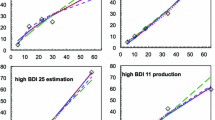Abstract
(1) An analysis of the method of paired comparisons shows that Case V and Case VI, the latter characterized by log-normal distributions and Weber's law for subjective continua, are fundamentally indistinguishable. Case VI produces a log-arithmetic interval scale of subjective magnitude. (2) It is demonstrated that the difference between discrimination scales according to Case V and from category rating is due to the difference between intra- and interindividual variability yielding different Weber functions.
Similar content being viewed by others
References
Adams, E. and Messick, S. An axiomatic formulation and generalization of successive intervals scaling.Psychometrika, 1958,23, 355–368.
Aitchison, J. and Brown, J.The lognormal distribution. Cambridge, Eng.: Cambridge Univ. Press, 1957.
Björkman, M. Variability data and direct quantitative judgment for scaling subjective magnitude. Rep. Psychol. Lab., Univ. Stockholm, 1960, No. 78.
Bradley, R. A. Some statistical methods in taste testing and quality evaluation.Biometrics, 1953,9, 22–38.
Bradley, R. A. Rank analysis of incomplete block designs. III. Some large-sample results on estimation and power for a method of paired comparisons.Biometrika, 1955,42, 450–470.
Cramér, H.Mathematical methods of statistics. Uppsala: Gebers, 1945.
Eisler, H. Empirical test of a model relating magnitude and category scales.Scand. J. Psychol., 1962,3, 88–96.
Eisler, H. On the problem of category scales in psychophysics.Scand. J. Psychol., 1962,3, 81–87.
Eisler, H. How prothetic is the continuum of smell?Scand. J. Psychol., 1963,4, 29–32.
Eisler, H. Magnitude scales, category scales, and Fechnerian integration.Psychol. Rev., 1963,70, 243–253.
Eisler, H. A general differential equation in psychophysics: Derivation and empirical test.Scand. J. Psychol., 1963,4, 265–272.
Eisler, H. and Ottander, C. On the problem of hysteresis in psychophysics.J. exp. Psychol., 1963,65, 530–536.
Ekman, G. Discriminal sensitivity on the subjective continuum.Acta Psychol., 1956,12, 233–243.
Ekman, G. Three methods of estimating discriminal dispersion. Rep. Psychol. Lab., Univ. Stockholm, 1957, No. 50.
Ekman, G. Weber's law and related functions.J. Psychol., 1959,47, 343–352.
Ekman, G. Some aspects of psychophysical research. In W. A. Rosenblith, (Ed.),Sensory communication. New York: Wiley, 1961.
Ekman, G. Measurement of moral judgment: A comparison of scaling methods.Percept. mot. Skills, 1962,15, 3–9.
Ekman, G. and Dahlbäck, B. A subjective scale of velocity. Rep. Psychol. Lab., Univ. Stockholm, 1956, No. 31.
Ekman, G. and Künnapas, T. Subjective dispersion and the Weber function. Rep. Psychol. Lab., Univ. Stockholm, 1957, No. 41.
Ekman, G. and Künnapas, T. Measurement of aesthetic value by “direct” and “indirect” methods.Scand. J. Psychol., 1962,3, 33–39.
Ekman, G. and Künnapas, T. Scales of aesthetic value.Percept. mot. Skills, 1962,14, 19–26.
Ekman, G. and Künnapas, T. Scales of conservatism.Percept. mot. Skills, 1963,16, 329–334.
Ekman, G. and Künnapas, T. A further study of direct and indirect scaling methods.Scand. J. Psychol., 1963,4, 77–80.
Engen, T. and Lindström, C. O. Psychophysical scales of the odor intensity of amyl acetate.Scand. J. Psychol., 1963,4, 23–28.
Finnie, B. and Luce, R. D. Magnitude-estimation, pair-comparison and successive intervals scales of attitude items. Mem. MP-9, U. Pennsylvania. Not dated.
Galanter, E. and Messick, S. The relation between category and magnitude scales of loudness.Psychol. Rev., 1961,68, 363–372.
Garner, W. R. An equal discriminability scale for loudness judgments.J. exp. Psychol., 1952,43, 232–238.
Garner, W. R. and Hake, H. W. The amount of information in absolute judgments.Psychol. Rev., 1951,58, 446–459.
Goude, G.On fundamental measurement in psychology. Stockholm: Almqvist and Wiksell, 1962.
Gridgeman, N. T. The Bradley-Terry probability model and preference tasting.Biometrics, 1955,11, 335–343.
Gulliksen, H. Introduction and historical background. In H. Gulliksen and S. Messick, (Eds.),Psychological scaling: Theory and applications. New York: Wiley, 1960.
Hald, A.Statistical theory with engineering applications. New York: Wiley, 1960.
Helm, C. E., Messick, S., and Tucker, L. R. Psychological models for relating discrimination and magnitude estimation scales.Psychol. Rev., 1961,68, 167–177.
Kendall, M. G.The advanced theory of statistics. Vol. I. London: Griffin, 1945.
Luce, R. D.Individual choice behavior. New York: Wiley, 1959.
Mosteller, F. The mystery of the missing corpus.Psychometrika, 1958,23, 279–289.
Sjöberg, L. An empirical application of a new case of the law of comparative judgment.Scand. J. Psychol., 1963,4, 97–107.
Stevens, S. S. On the psychophysical law.Psychol. Rev., 1957,64, 153–181.
Stevens, S. S. Measurement, psychophysics, and utility. In C. W. Churchman, and P. Ratoosh (Eds.),Measurement: Definitions and theories. New York: Wiley, 1959.
Stevens, S. S. Sic transit gloria varietatis?Contemp. Psychol., 1959,4, 388–389.
Stevens, S. S. Ratio scales, partition scales, and confusion scales. In H. Gulliksen and S. Messick (Eds.),Psychological scaling: Theory and applications. New York: Wiley, 1960.
Stevens, S. S. The surprising simplicity of sensory metrics.Amer. Psychologist, 1962,17, 29–39.
Stevens, S. S. and Guirao, M. Loudness, reciprocality, and partition scales.J. acoust. Soc. Amer., 1962,34, 1466–1471.
Suppes, P. and Zinnes, J. L. Basic measurement theory. In R. D. Luce, R. R. Bush, and E. Galanter (Eds.),Handbook of mathematical psychology. Vol. I. New York: Wiley, 1963.
Thurstone, L. L. A law of comparative judgment.Psychol. Rev., 1927,34, 273–286.
Torgerson, W. S.Theory and methods of scaling. New York: Wiley, 1958.
Torgerson, W. S. Distances and ratios in psychophysical scaling.Acta Psychol., 1961,19, 201–205.
Author information
Authors and Affiliations
Additional information
This research was supported by the Humanistic Faculty of the University of Stockholm and by the Swedish Social Science Research Council. I am indebted to Mr. U. Forsberg for computational assistance.
Rights and permissions
About this article
Cite this article
Eisler, H. The connection between magnitude and discrimination scales and direct and indirect scaling methods. Psychometrika 30, 271–289 (1965). https://doi.org/10.1007/BF02289491
Received:
Revised:
Issue Date:
DOI: https://doi.org/10.1007/BF02289491




